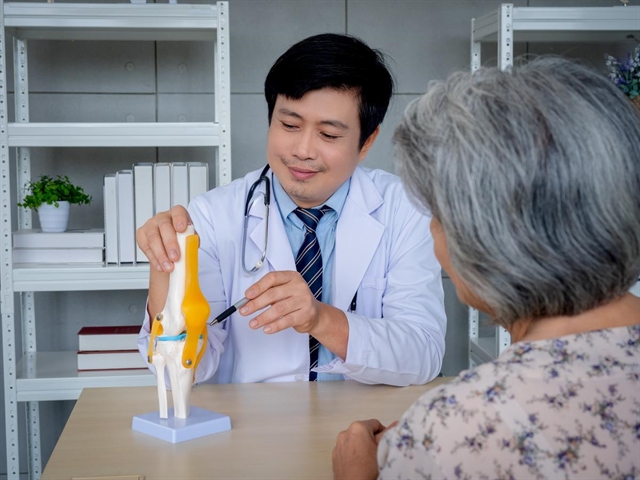 Life & Style
Life & Style

 |
| Dr. Andres Sosa. — Photo courtesy of Family Medical Practice |
Dr. Andres Sosa*
With increasing life expectancy, there is a growing interest in preserving the natural cartilage in our joints to delay the need for knee replacements. This applies not only to athletes but also to individuals who engage in recreational sports. Taking care of our joints is crucial for maintaining optimal performance and overall joint health. One of the key strategies in protecting the knees is preserving the meniscus, a vital component of the knee structure.
As a knee surgeon, my main objective is to assist my patients in preserving the integrity of their meniscus or repairing meniscal tears whenever feasible, rather than resorting to the complete removal of the meniscus through surgical excision, which was more common in the past.
 |
| Since 2016, there has been a significant shift towards meniscal preservation. — Photo shutterstock.com |
What are the menisci?
The menisci are two annular soft structures situated within the knee joint, positioned between the femoral (thigh bone) and tibial (shin bone) articular surfaces. They play a crucial role in several essential biomechanical functions, including load transmission, shock absorption, stability and joint lubrication.
The menisci can be likened to the rubber ring found in a blender. Just as the ring prevents fluid from leaking out, the menisci serve a similar purpose within the knee joint. They ensure proper fluid distribution and prevent excessive friction. Due to the unique anatomy of the knee joint, where the curved surface of the femur interacts with the flatter tibial surface, the menisci play a crucial role. They act as adaptable structures that bridge the gap between these two surfaces with different shapes.
However, it's important to note that the menisci are not rigid structures. During movements involving pivoting or full flexion of the knee, the menisci can become susceptible to compression, tears, or even detachment.
Following sports activities, the pressure within the knee often rises, and in the presence of a meniscal tear, this can lead to the leakage of joint fluid. As a result, the fluid may accumulate in nearby soft tissues, causing pain, knee effusion (swelling), and limited range of motion. This condition is commonly referred to as Baker's cyst, and it is directly associated with meniscal tears.
While meniscal injuries are commonly associated with professional athletes, impact sports, and martial arts, smaller tears can also occur in runners, football players, tennis players, golfers, and yoga practitioners. These tears, even if small, can cause pain and knee effusion. It is not uncommon to find concomitant ligament injuries (such as Anterior or Posterior Cruciate Ligament) and meniscal injuries together.
“Cut it out” and the problem solved?
For decades, surgical excision was the go-to treatment for meniscal tears, providing temporary pain relief. However, removing the meniscus significantly increases the risk of developing knee osteoarthritis. Without the protective cushioning of the meniscus, the articular surfaces are exposed to daily friction and impacts, leading to degenerative changes.
Studies have shown that after meniscectomy, rapid chondrolysis (degenerative cartilage changes) occurs, particularly in athletes and patients who subject their knees to excessive loading. Meniscal removal increases shear stress on the knee's articular surfaces by 200 per cent compared to meniscal repair.
Since 2016, there has been a significant shift towards meniscal preservation, prompted by a consensus celebrated at the FIFA-approved Rizzoli Orthopedic Institute in Bologna, Italy, known as "Save the meniscus." Scientific research has demonstrated the relevance of meniscal repair in preserving knee performance and preventing osteoarthritis.
How do I manage meniscal tears?
Physical examination is a valuable tool, and an MRI can provide confirmation of a meniscal tear. X-rays and ultrasounds are equally important for assessing other structures and bone quality in the knee.
Rehabilitation following meniscal repair should prioritise the slow biological healing process of the meniscus, making physical therapy essential. Returning to sports activities should be delayed for approximately 2-4 months. However, a significant percentage (86 to 91 per cent) of patients can eventually resume playing.
It's important for patients to understand that there is an 8-20 per cent risk of failure, re-rupture, and the need for re-operation, especially in athletes. Nonetheless, the long-term outcomes of meniscal repair are superior to meniscectomy due to the protective role of the meniscus in preserving the articular cartilage.
In conclusion, the current approach to treating meniscal tears is to prioritise repair whenever possible, avoiding meniscectomy whenever feasible. This principle applies to individuals of all ages, genders, and activity levels. Family Medical Practice
*Dr. Andres Sosa joined FMP in 2018 and is responsible for all orthopaedic and trauma cases. He is also a sports nutrition expert from Major University (Chile) and is fluent in English, Italian, and Spanish.




